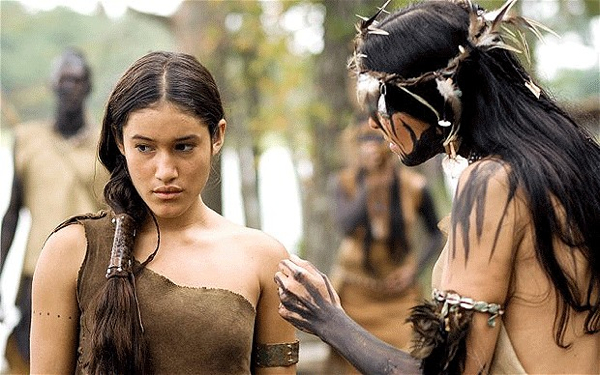Movie review by Greg Carlson
The myth of Pocahontas is simultaneously durable and sketchy, and perhaps this is part of its appeal. Filmmaker Terrence Malick’s treatment of the story necessitates a great deal of invention, but the final impact of his fourth feature “The New World” is somewhat disappointing when lined up against his other films. Malick devotees need no convincing that he is a filmmaker unlike any other, a master director unafraid to put visual lyricism ahead of conventional, dialogue-driven plotting. “The New World” displays nearly all of Malick’s familiar touches, but it fails to replicate the epiphanies and grandeur of his 1970s masterworks “Badlands” and “Days of Heaven.”
The first section of “The New World” is the strongest, as a British exploration led by Captain Newport (Christopher Plummer) arrives in Virginia to the magisterial strains of Wagner’s “Das Rheingold” as the native Powhatan emerge from the trees to greet the strange-looking aliens. Spared from the hangman’s noose by Newport, Captain John Smith (Colin Ferrell) is ordered to lead an expedition to the natives’ settlement. While the other members of his group are killed, Smith is miraculously saved by Pocahontas (Q’orianka Kilcher), the daughter of the tribal leader. Smith stays with the natives for some time, during which he forms a deep bond with the curious and beautiful Pocahontas.
Malick lavishes attention on the closeness of Smith and Pocahontas, painting the unhurried lifestyle of the natives as a harmonious balance between human beings and nature. Mostly avoiding any explicitly depicted sexual relationship between Smith and Pocahontas, Malick nevertheless suggests an eroticized, prelapsarian sensuousness that discreetly sidesteps the considerable age difference between the central characters, as well as reinforces the fantasy construction that love between a Native American and an Englishman excuses the ugly reality of what Europeans would inflict during colonization and beyond.
Later, Pocahontas marries John Rolfe (Christian Bale), and her sad transformation is manifested in the change from her customary furs and skins to the constricting and uncomfortable togs worn by “proper” ladies. Arriving in England for an audience with royalty, Pocahontas discovers her very own new world, and ace cinematographer Emmanuel Lubezki’s camera fixes on manicured hedges and soaring architecture in a way that parallels Smith’s earlier fascination with Powhatan culture. Pocahontas, now christened Rebecca, comes back into focus in a series of moments that bear Malick’s ethereal, almost mystical, stamp. These last moments reverberate with a bittersweet and tender sense of sorrow.
Like Malick’s other films, “The New World” will no doubt benefit from multiple viewings, not to mention the inevitable stream of scholarly articles that will dissect the director’s purposefully unstated intentions. One leaves “The New World,” however, with the gnawing impression that there should have been something more to it. Malick detractors will also carp about the fuzzy internal monologues delivered by Pocahontas, Smith, and Rolfe, which lack the haunting urgency of Linda Manz’s voiceovers in “Days of Heaven.” Despite its shortcomings, “The New World” surpasses the majority of the thoughtless drivel released to the public, and even those unfamiliar with Malick’s other movies will marvel at the film’s many charms.
